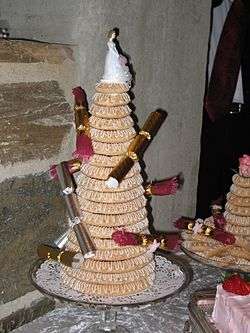Kransekake
|
The top layers of a kransekage cake, decorated with chocolate as well as the traditional white glaze | |
| Alternative names | kransekage, kransekake |
|---|---|
| Type | Cake |
| Course | Dessert |
| Place of origin | Norway |
| Serving temperature | Weddings, Christmas, Baptism, Confermation, New Year's Eve, Birthdays and Anniversaries |
| Main ingredients | Almonds, sugar, egg whites |
| Variations | Overflødighedshorn |
|
| |
The kransekage (literally wreath cake) is a traditional [Norwegian cuisine|Norwegian]] (kransekake/tårnkake (tower cake)) confection, usually eaten on special occasions such as weddings, baptisms, Christmas, or New Year's Eve.
Cake
Kransekage take the form of a series of concentric rings of cake, layered on top of each other in order to form a steep-sloped cone shape—often 18 or more layers—stuck together with white icing.[1] Kransekage cake rings are made with almonds, sugar, and egg whites.[1] The ideal kransekage is hard to the touch, yet soft and chewy.
The original variant used at weddings is called overflødighedshorn and is shaped like a cornucopia and filled with chocolates, cookies, and other small treats. Sometimes a bottle of wine or akvavit is placed in the center, and the cake is decorated with ornaments such as crackers and flags.
Serving
This confection is served by separating individual rings and breaking them into smaller pieces.
Traditions
One cultural tradition is for the bride and groom to lift the top layer of the cake at their wedding. The number of cake rings that stick to the top one when they lift it is said to be the number of children the couple will have.[1]
See also
Notes
References
- O'Leary, Margaret Hayford (2010): Culture and Customs of Norway, ABC–CLIO, ISBN 9780313362484
- Denmark.dk: "KRANSEKAGE" A Danish New Year tradition, Ministry of Foreign Affairs of Denmark. An instructional video.

